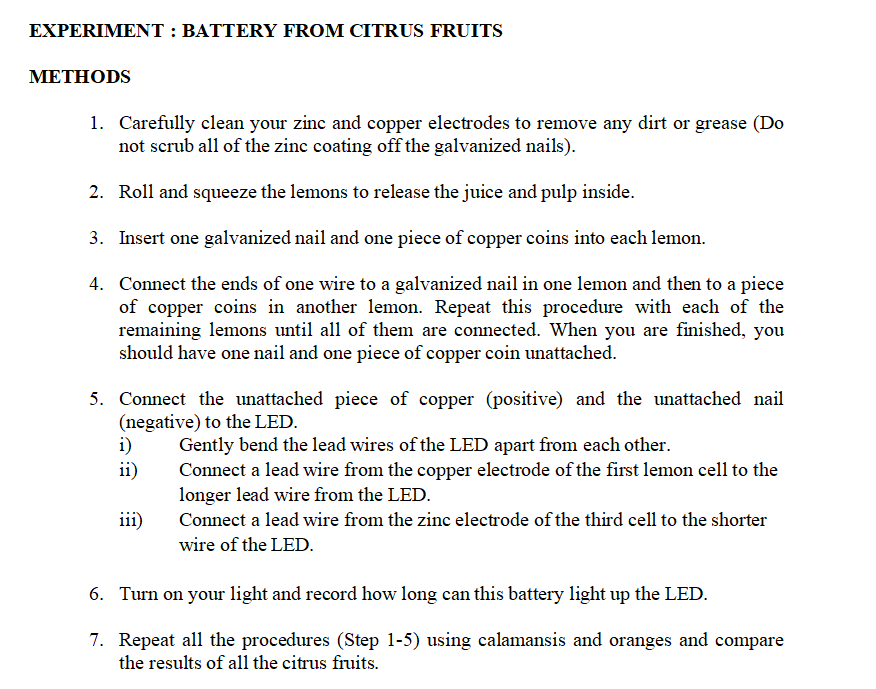Chemistry: An Atoms First Approach
2nd Edition
ISBN:9781305079243
Author:Steven S. Zumdahl, Susan A. Zumdahl
Publisher:Steven S. Zumdahl, Susan A. Zumdahl
Chapter17: Electrochemistry
Section: Chapter Questions
Problem 120AE
Related questions
Question
Discuss the

Transcribed Image Text:EXPERIMENT : BATTERY FROM CITRUS FRUITS
МЕТНODS
1. Carefully clean your zinc and copper electrodes to remove any dirt or grease (Do
not scrub all of the zinc coating off the galvanized nails).
2. Roll and squeeze the lemons to release the juice and pulp inside.
3. Insert one galvanized nail and one piece of copper coins into each lemon.
4. Connect the ends of one wire to a galvanized nail in one lemon and then to a piece
of copper coins in another lemon. Repeat this procedure with each of the
remaining lemons until all of them are connected. When you are finished, you
should have one nail and one piece of copper coin unattached.
5. Connect the unattached piece of copper (positive) and the unattached nail
(negative) to the LED.
i)
ii)
Gently bend the lead wires of the LED apart from each other.
Connect a lead wire from the copper electrode of the first lemon cell to the
longer lead wire from the LED.
iii)
Connect a lead wire from the zinc electrode of the third cell to the shorter
wire of the LED.
6. Turn on your light and record how long can this battery light up the LED.
7. Repeat all the procedures (Step 1-5) using calamansis and oranges and compare
the results of all the citrus fruits.
Expert Solution
This question has been solved!
Explore an expertly crafted, step-by-step solution for a thorough understanding of key concepts.
Step by step
Solved in 2 steps

Knowledge Booster
Learn more about
Need a deep-dive on the concept behind this application? Look no further. Learn more about this topic, chemistry and related others by exploring similar questions and additional content below.Recommended textbooks for you

Chemistry: An Atoms First Approach
Chemistry
ISBN:
9781305079243
Author:
Steven S. Zumdahl, Susan A. Zumdahl
Publisher:
Cengage Learning


Chemistry
Chemistry
ISBN:
9781305957404
Author:
Steven S. Zumdahl, Susan A. Zumdahl, Donald J. DeCoste
Publisher:
Cengage Learning

Chemistry: An Atoms First Approach
Chemistry
ISBN:
9781305079243
Author:
Steven S. Zumdahl, Susan A. Zumdahl
Publisher:
Cengage Learning


Chemistry
Chemistry
ISBN:
9781305957404
Author:
Steven S. Zumdahl, Susan A. Zumdahl, Donald J. DeCoste
Publisher:
Cengage Learning

Chemistry for Engineering Students
Chemistry
ISBN:
9781337398909
Author:
Lawrence S. Brown, Tom Holme
Publisher:
Cengage Learning

Chemistry: Matter and Change
Chemistry
ISBN:
9780078746376
Author:
Dinah Zike, Laurel Dingrando, Nicholas Hainen, Cheryl Wistrom
Publisher:
Glencoe/McGraw-Hill School Pub Co
